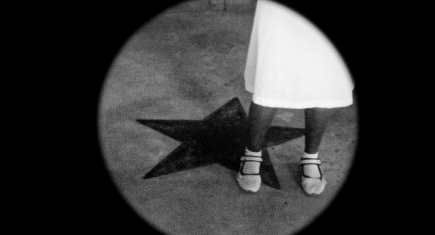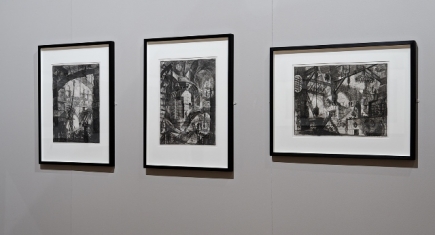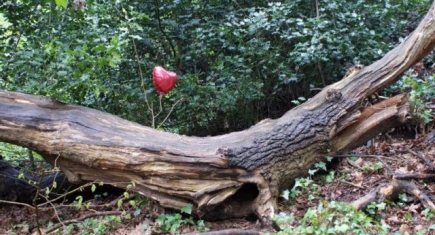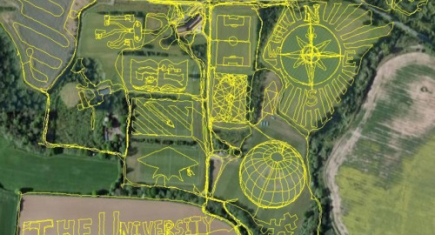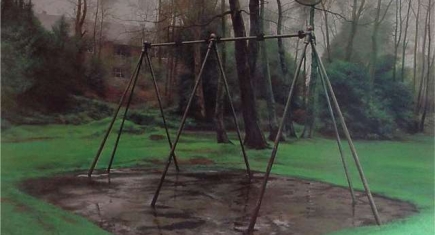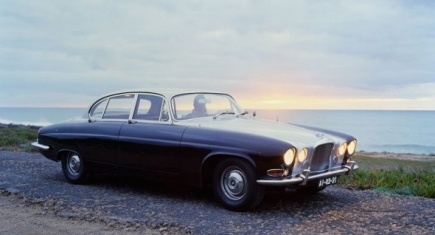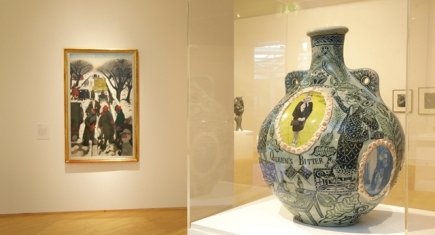Mead Gallery Exhibitions 2010
Lindsay Seers - It has to be this way2
Co-commissioned by the Mead Gallery and the National Gallery of Denmark
Sat 9 Oct – Sat 11 Dec 2010
To see a sneak peak of the exhibition installation in progress click on the trailer tab above.
Lindsay Seers seeks to unravel the strange disappearance of a young woman, Christine Parkes, her stepsister. Old letters, her stepsister’s notes and a box of photographs act as her point of departure as she sets out to find the truth, a truth which leads her to tales of diamond smuggling in Western Africa.
It has to be this way2 is a large architectural structure, inside a video installation is projected onto a circular screen. The apparently unconnected images filling this light pool in the intense darkness are fragmentary, the viewer cannot piece them together to construct a complete sequence of events. This is because Lindsay Seers’ work traces not simply a narrative account emerging from the disappearance of her stepsister, but the constantly transforming quality of memory itself.
Her work centres on a tension between fact and fiction. Using different voices in the same narrative challenges the idea that one is either true or false. Seers also questions the truthfulness of the camera, can this as apparatus be relied upon? Or are in fact creative impulses within all documentary texts and images?
An exhibition of prints from the eighteenth century Italian artist Giovanni Battista Piranesi creates a dialogue with the Lindsay Seers’ work and their shared preoccupations with light and dark, reality and fantasy, loss and displacement.
This exhibition has been co-commissioned by the National Gallery of Denmark and Mead Gallery in association with Matt’s Gallery, London. Lindsay Seers is represented by Matt’s Gallery, London. It tours to BALTIC in 2011.
Piranesi's Prisons
A Mead Gallery Exhibition
Sat 9 Oct – Sat 11 Dec 2010
Giovanni Battista Piranes’s mid eighteenth century etchings create a series of 16 haunting images of imaginary prisons. Towering fantastical architecture, endless staircases and dreadful machinery create nightmarish scenes that have fuelled the imagination of Romantic writers and contemporary game designers.
On loan from the University of Manchester, Piranesi’s prints create a dialogue with Lindsay Seers’ work, sharing a preoccupation with light and dark, real and fantastic, loss and displacement.
Lorsen Camps: Journeys into the Disregarded
An exhibition led by Coventry-based artist Lorsen Camps
Sat 29 May 2010 – Sat 3 Jul 2010
Journeys into the Disregarded will highlight the beauty found in the ordinariness of life. Lorsen Camps will be inviting artists, students and the general public to make short journeys from the University campus discovering precious details of our surroundings that often go unnoticed. Photographs will be taken, poems and prose written, found objects gathered.
The resulting work will be exhibited on campus in the Coventry Centre for Contemporary Art, one of Bob and Roberta Smith’s gallery structures which made its first appearance at the Mead Gallery in 2009.
Traverse Me: A new map of campus by Jeremy Wood
A Mead Gallery commission
Sat 29 May – Sat 3 Jul 2010
Like Hamish Fulton and Richard Long, Jeremy Wood makes works of art that are about walks. He uses Global Positioning System (GPS) technology to create drawings across landscapes.
The Mead Gallery has commissioned him to make a map, drawn by walks across campus, that invites the viewer to see a different landscape to that which surrounds them.
It questions the possibilities of where they are and inspires a personal reading of their movements and explorations of the campus.
Printed maps are available from the gallery and as a beautiful, limited edition silkscreen print.
Destination
Works from the University Art Collection
Sat 1 May – Sat 29 May 2010
This is a rare opportunity to see University Art Collection works, new and old, displayed together in a temporary exhibition that shows how artists have explored landscape and ideas about place and journeys.
Artists include Mary Fedden (pictured), Hamish Fulton, Fay Godwin, Richard Long, Marcel Mouly, Anne Redpath and George Shaw.
This exhibition complements From Here To There: Contemporary Work from the Arts Council Collection at the Herbert Art Gallery & Museum in Coventry from 22 May – 18 July.
Miguel Palma: Private View/Jaguar Project
A Mead Gallery Exhibition
Sat 1 – Sat 29 May 2010
Miguel Palma is recognised as one of the most significant artists living in Portugal today and has played a key role in the developing profile of contemporary Portuguese art. His work examines ideas about value, transaction, risk and technology. A particular focus is the automotive industry. He has built cars and raced them and developed prototypes such as a solar powered car and a VW combi that has a transparent lung on its back into which all the exhaust fumes pour.
In 2009 he acquired a Jaguar Mark X which bears the legend, ‘Jaguar Ltd, Coventry, England’. It had been made in this city in 1963 for export and was sold in Paris to a chocolate manufacturer. It was later bought by a Dutch doctor and taken to Lisbon. Looking through the archives at the Jaguar Daimler Heritage Centre, Palma found publicity shots featuring the new car by the Discoveries Monument, installed in Lisbon in 1960. With such a strong Lisbon – Coventry link, he decided to bring the car back to Coventry in an epic journey that would be filmed.
To support this project, Palma developed another project, featuring the car, which he called ‘Private View’. He placed an advertisement in the European art press, offering twelve drawings to different collectors who would be prepared to come to Lisbon, have a tour in the Jaguar, a lunch and choose their drawing, all in front of the camera. The twelve separate films explore the private relationships between artist, artwork and collector and open the process of collecting art to the scrutiny of the gallery visitor.
Palma also made 47 drawings, one for each year of the car’s life, using images from the Jaguar Daimler Heritage Archive. Hung “salon style” in the Mead, they resemble pages from a photograph album or scrapbook. Some are annotated to convey the car’s own fantasies about its role, in images which are already constructed to create an image of allure and sophistication for the car.
There is a Portuguese word “saudade” which describes a feeling of nostalgic longing for something or someone that was once loved and which is lost. It often carries a fatalist tone and a repressed knowledge that the object of longing might really never return. This exhibition is imbued with nostalgia for not only a particular car, but for a period in the history of Coventry. And of course, the car has broken down and its return journey has, with poetic irony, been halted. There is no going back.
Unpopular Culture: Grayson Perry selects from the Arts Council Collection
A Hayward Touring Exhibition from Southbank Centre
Fri 22 Jan – Sat 13 Mar 2010
Grayson Perry was catapulted into the public consciousness in 2003 when he won the Turner Prize, accepting his award dressed as his transvestite alter-ego Claire. A unique figure in the international art scene, Perry is best known for his ceramic coil pots which he adorns with subject matter ranging from his childhood in Essex, his transvestism, and his reflections on British art and society.
Perhaps less recognised is Perry’s role as a curator. This exhibition highlights this recent aspect of Perry’s practice and offers a unique and personal view of the Arts Council Collection. Perry’s selection will be presented alongside new work made by him in response to the Collection.
Perry’s selection features modern British paintings, sculpture and photographs that embody a quiet nostalgia and restraint. Rather than retreat into a world of rose-tinted romanticism, Perry presents an alternative view of British art, one that reassesses the relationship between past and present, and questions the boundaries between the radical, the conservative, and the radically conservative.
Exhibiting Artists:
Michael Andrews; Kenneth Armitage; Frank Auerbach; Gerry Badger; Clive Barker; Elinor Bellingham-Smith; John Benton-Harris; Ian Berry; John Bratby; Edward Burra; Anthony Caro; Lynn Chadwick; Robert Colquhoun; Elisabeth Frink; Duncan Grant; Bert Hardy; Anthony Hatwell; David Hepher; Barbara Hepworth; Thurston Hopkins; David Hurn; Bryan Kneale; Margaret Lovell; Alan Lowndes; L.S. Lowry; Henry Moore; Francis Morland; Tish Murtha; John Myers; Paul Nash; Eduardo Paolozzi; Martin Parr; Victor Pasmore; Christine Pearcey; Edwin Pickett; John Piper; Tony Ray-Jones; Alan Reynolds; Brian Robb; William Roberts; George Rodger; Leonard Rosoman; Meg Rutherford; William Scott; Jack Smith; Ruskin Spear; Homer Sykes; William Turnbull; Patrick Ward; Carel Weight; John Wragg; Bryan Wynter.

